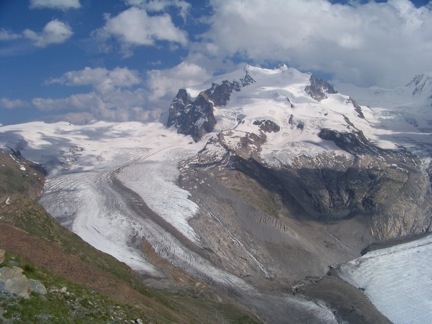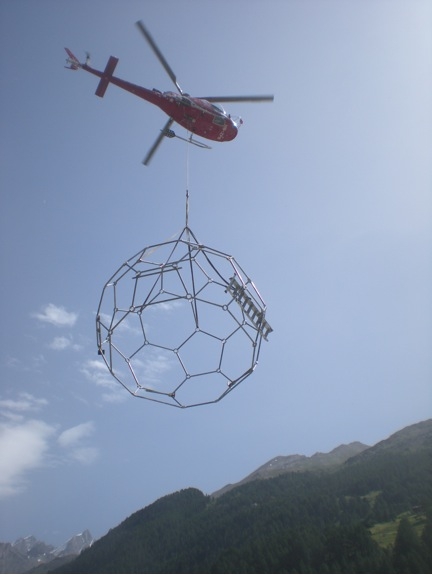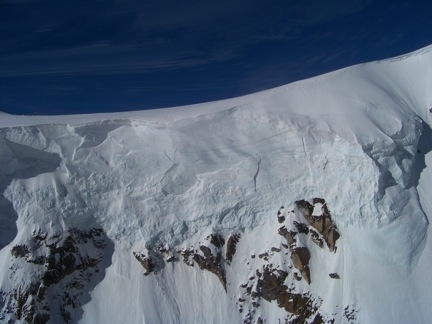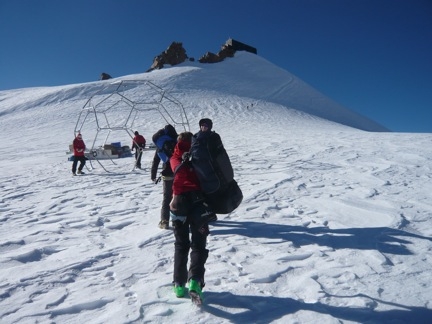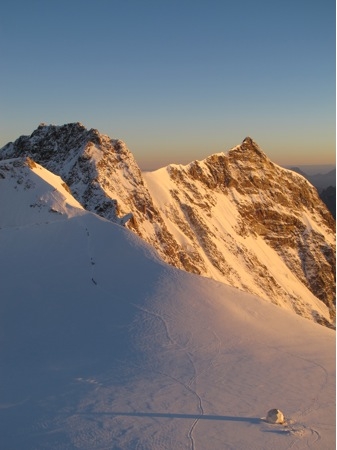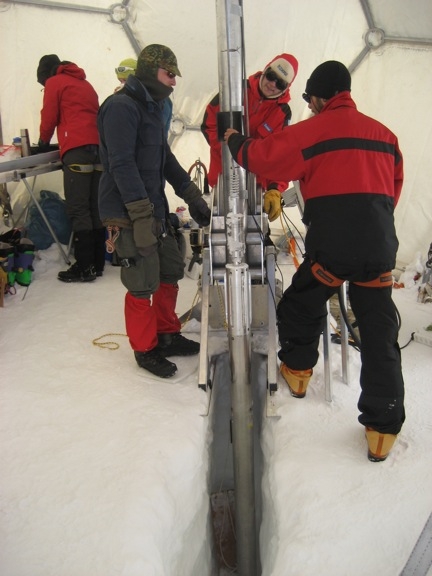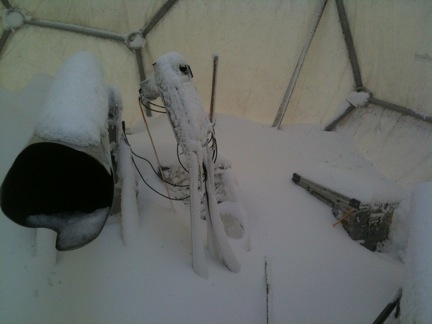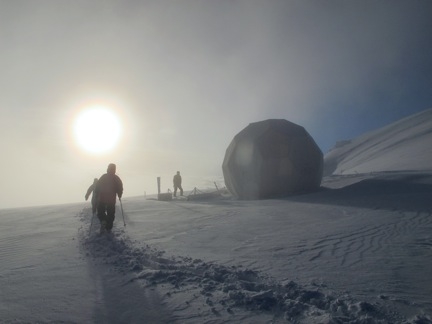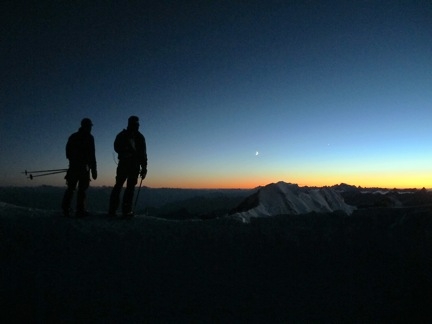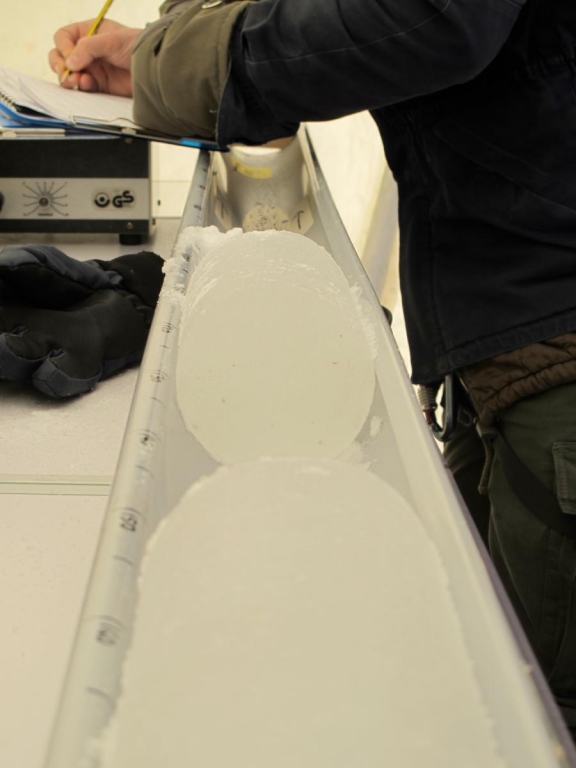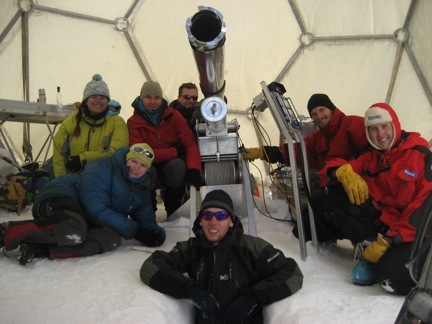Colle Gnifetti 2013
Colle Gnifetti 2013
Field Team Members: Pascal Bohleber, Nicole Spaulding, Remo Walther, Helene Hoffman, Johanna Kerch, Martin Hackel, Samuel Marending
Location: Swiss/Italian Alps
Dates: August 5 – August 11, 2013
Funding Support: Arcadia Fund
The Colle Gnifetti glacier of the Monta Rosa Massif on the Swiss-Italian border is perfectly situated to offer insight into the intersection of environment (climate) and culture (history of the economy, political stability, pollution, disease) in medieval Europe. While ice cores previously collected at Colle Gnifetti were sampled at state-of-the-art resolution for the time, it was nevertheless impossible to differentiate annual or finer layering in the period older than 1500 A.D. The 2013 Colle Gnifetti expedition thus sought to collect a new ice core that could be analyzed using the ultra-high-resolution laser based technology developed in the Climate Change Institute’s W.M. Keck Laser Ice Facility.az
Team leader Pascal Bohleber (University of Heidelberg), drillers Remo Walther and Samuel Marending (University of Bern), and field assistants Nicole Spaulding (University of Maine), Helene Hoffman, Johanna Kerch, and Martin Hackel (University of Heidelberg) carried out the expedition, which took place between August 5th-12th 2013. Drilling of the ~73 m ice core was achieved in only three days, although bad weather and electrical delays extended our total time on the glacier to seven days.
We began our journey with a short period of acclimatization to high altitude at the Gornergrat Observatory (3120 m.a.s.l). From there we were able to observe the shifting weather at our destination. When a window of good weather opened, we were taken to the glacier by helicopter. Touching down next to our tent frame and gear, which had been delivered two days earlier, we took only a short moment to bask in the beauty of our surroundings before jumping into the task at hand. Preparing the tent for drilling required attaching an impossibly heavy skin that was still easily caught by the wind. It took our seven-person crew and one passing Italian mountaineer three hours to finish the task! After setting up the tent, we excavated a 1.6 m pit for the drill, set up the ice core processing station and tested the generators. Despite our original trials with the tent, we were able complete those tasks, drill our first two meters of ice core, climb the 100 meters of vertical ascent to the hut where we would sleep and arrive in time for dinner!
Our second day on the glacier involved much more digging, as we evacuated a trench to store boxes of cored ice, and hours of fast-paced drilling. Throughout the day, cloud cover in the valley increased and we were subjected to an interesting array of precipitation. A sample of the soft hail (graupel) that fell just prior to our lunch was collected for posterity. We continued to drill, keeping a close eye on the weather. While processing, we noted multiple layers of Saharan dust (distinguished by its red brown color), an insect at 28 m that could be used for 14C dating and the transition from firn to ice at 32 m. By 4 PM the visibility had become greatly reduced and we were forced to beat a quick retreat to the hut at the first sign of lightning in the distance.
Unbeknownst to us, we were to remain in the hut for the next two days as limited visibility, high winds, at least a foot of fresh snow, and a few spectacular lightning storms kept us from drilling. Throughout those two days snow blew into the tent and worked its way into our equipment. As a result, when the weather stabilized and we were able to return to the drill site, we experienced some electrical malfunctions that required all the resourcefulness and social connections Remo and Sam possessed to fix it. We were waylaid by the electrical malfunction for one and one half days, but were able to continue doing science as we exhumed the borehole casing from a 2010 drilling effort and deployed a borehole camera. Once the electrical components were fixed, we drilled until dusk – ceasing operations at a total depth of 52 m. We reached the hut as the setting sun bathed the Matterhorn in an orange glow and darkness fell. It was a magnificent sight.
The next day we decided to forgo breakfast at the hut and descended with our luggage to the drill site as the sun was rising. Hopes were high that if we put in enough hours, we would reach bedrock that day. We drilled through the day with no problems, noting the first small stones, indicative of bedrock at 68 meters. Around 73 meters when the drill barrel repeatedly came back empty and the cutters became increasingly chewed up by rock, we declared that bedrock had been reached. Given the bad weather and electrical issues we had experienced, our team was elated and there were hugs all around. After our small celebration we broke down camp, buried our ice core boxes and were rewarded with a flight down to the valley, a hot shower and good nights sleep.
The next day, very high winds prevented us from retrieving our cargo and samples. We filled the day with restless pacing and a variety of organizational tasks before making what would be our final ascent to the Gornergrat. When the weather improved, we split into a glacier group responsible for digging up the ice core boxes and helping the helitechs load them into slings and a valley group responsible for receiving the cargo and getting the ice cores transferred to a refrigerated train car. Everything and (and everyone) was transported to the valley in seven short flights. Our final job was to deconstruct the tent frame. As we did so, we were able to watch the train containing our ice makes its way out of Zermatt. After a quick lunch we did the same, all the while making plans to begin our investigation of the amazing archive we had just collected.
The ultra-high-resolution measurements of dust and other impurities contributed by the Climate Change Institute will be combined with a Harvard University’s new historical geodatabase of the climate of medieval Europe from written sources, 14C and physical properties measurements from the Institut für Umweltphysik, University of Heidelberg (Germany), continuous chemistry and dust measurements from the Physics Institute, University of Bern (Switzerland), as well contributions from the Alfred-Wegener Institute-Bremerhaven (Germany) and the Department of Geosciences, University of Fribourg (Switzerland). The resulting record may allow the first detailed, ice core-based assessment of human-climate interactions during the first millennium AD. The new technology is minimally destructive and will allow the permanent preservation of the new ice core record. The project is supported by a grant from the Arcadia Fund.
- The Gornergrat Hotel and Observatory where we begin our acclimatization to high altitude. Photo by Martin Hackel.
- View of Dufourspitze, the main summit of Monta Rosa, and the Gorner Glacier from the Gornergrat Observation Deck. Photo by Helene Hoffman.
- An Air Zermatt helicopter slings the drill tent frame from the valley up to the glacier. Photo by Johanna Kerch.
- View of the glacier cliff from the helicopter. Note the drill tent frame in the upper right hand corner. The reddish brown layers are from Saharan dust falls. Photo by Samuel Marending.
- The team arrives at the glacier. Refugio Capanna Margherita, our home for the week, is visible on the peak above. Photo by Remo Walther.
- The fully established drill site as seen from Refugio Cappana Margherita. Photo by Nicole Spaulding.
- Drilling and logging inside the tent. Photo by Nicole Spaulding.
- Buried equipment after two days of snow, high wind, and lightning. Photo by Pascal Bohleber.
- An early morning descent allowed us to get back on schedule despite electrical and weather delays. Photo by Nicole Spaulding.
- A rewarding sunset after a long day of drilling. Photo by Nicole Spaulding.
- Small pieces of rocks in the ice signal proximity to bedrock. Photo by Nicole Spaulding.
- A happy team after reaching bedrock at ~73 meters depth. Left to Right – Pascal Bohleber, Helene Hoffman, Nicole Spaulding, Johanna Kerch, Martin Hackel, Remo Walther and Samuel Marending. Photo by Pascal Bohleber (with self-timer).



